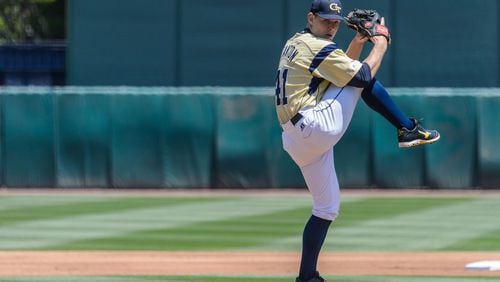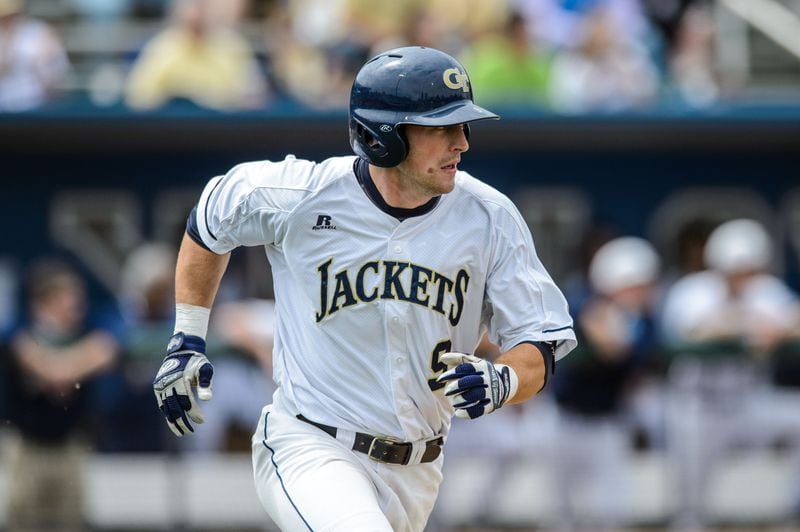1. The starting rotation for Georgia Tech's opening weekend of the season (St. John's Friday afternoon, followed by a doubleheader with Fordham Saturday) with feature three lefthanders – Jonathan King, Ben Parr and Devin Stanton. It's a first in Hall's career at Tech. Also the 2014 opening-day starter, King is returning from missing almost the entire season after a shoulder injury. Parr is a sophomore who had a 2.62 ERA as a freshman in 18 appearances and 10 starts. Stanton, a senior and two-time team captain, turned into a dependable starter last season, finishing with a 2.24 ERA in 18 appearances and 12 starts.
As he rehabilitated his shoulder injury, King said he benefited from sitting and watching pitchers like Parr and Stanton. He deemed himself 100 percent earlier this month.
Said King, “I feel really good.”
Cole Pitts, who is coming back from Tommy John surgery (he suffered his injury the day after King injured his shoulder), will be another option.
“I’ve been very encouraged by both those guys,” Hall said of King and Pitts. “If we decide to start those guys, it gives us a little more flexibility, or at least more direction, in what we’re going to do at the end.”
Stanton, who himself came back from Tommy John surgery after an elbow injury in 2012, gave high marks to Pitts.
“We had surgery pretty much on the same day, just two years apart,” Stanton said. “He is far ahead of where I was at this point in time. I can’t give him and then the sports medicine people enough credit. He’s done everything he needs to do.”
2. A bigger concern with the pitching will be replacing the two bullpen aces, Dusty Isaacs and Sam Clay. Isaacs, a senior last season, had seven saves, a 1.92 ERA and a .232 opponent batting average. Clay, who signed with Minnesota after getting drafted in the fourth round following his sophomore season, had a 1.26 ERA (second lowest in Tech history) in 31 appearances.
Possibilities include Zac Ryan, Ben Schniederjans, Matthew Gorst and Tanner Shelton.
“I think if I’m going to lose sleep at night over something, it’s who’s going to fill the roles of Dusty Isaacs and Sam Clay, because those two guys were very instrumental in our success last year,” Hall said.
While no returnees put up great numbers last season, there may be some hope in the fact that Clay made huge strides from his freshman to sophomore season. His ERA dropped from 6.94 to 1.26 and his strikeout/walk ratio improved from 17/20 in 23.1 innings as a freshman to 64/29 in 57 innings last season.
3. A new ball with lower seams will change the game, though it's unclear how much. After the NCAA mandated less lively bats prior to the 2011 season to address the offensive tilt that had taken over the game, the pendulum swung a little too far the other way. The new ball, which creates greater ball flight because of reduced drag, is expected to push the game back more towards offense again. (Presumably, the pitching mound will be raised in four years to give the edge back to pitching and defense, and then in another four years a rule change will require four strikes for a strikeout.)
“I can’t tell a difference off the bat, but you’ll be hitting them in BP and they’ll be going farther than they’ve ever gone before, so there’s obviously something there,” left fielder/third baseman Matt Gonzalez said.
A study performed for the NCAA found that flat-seamed balls launched from a pitching machine with speed, launch angle and spin rate similar to a typical home run traveled 20 feet farther than a raised-seam baseball.
Tech’s offense could use the infusion. Last season, the Jackets were No. 157 in the country in home runs per game, at .33. Tech was 11th in 2013 (.91) and 21st in 2012 (.83). The numbers will go up this year, if for no other reason than the new ball, but Hall also believes that a team that is a year older and stronger will have its own influence on power numbers.
4. A freshman to note is outfielder and first baseman Kel Johnson, of Palmetto. Johnson, who made the USA Baseball 18-under national team, is one of the best hitters on the roster and "I think he's an elite hitter down the road," Hall said.
Johnson, a righty, has power to all fields and in preseason practice hit home runs off the Brock football facility beyond the left-field fence.
“If you’re going to throw him the fastball, definitely make sure it’s down, because he’ll hit it a long way, for sure,” second baseman Thomas Smith said.
Interesting about Johnson: He was home schooled through high school.
5. Look for Gonzalez, who has mostly played left and third, to build on his solid sophomore season (.314, ACC-best 21 doubles, team-best 37 RBI, nine outfield assists). Gonzalez worked on his approach at the Cape Cod league and feels better about changes he made.
“The big thing for me is, I want to swing at better pitches and maybe get some more walks,” he said.
6. Tech will also look for power from first baseman/catcher A.J. Murray, whose four home runs last season led the Jackets. Murray was one of the top players last summer in the Cape Cod League, finishing in the top five in home runs (six in 161 at-bats) and RBI (32) in the most prestigious wooden-bat league in the country.
“He looks like he carried things over from the summer pretty good,” Smith said. “That’s what we’ll need, for sure.”
Regarding Smith, Hall will try to find a spot for him again this season. A true walk-on – as a freshman, he showed up unannounced in Hall’s office to ask to try out, and has gone on to start 130 games in three seasons – he has mostly played second and short. He was second-team All-ACC last year with a .301 batting average and .392 on-base percentage. However, freshman Wade Bailey looks like the choice at second base, and Murray and Johnson also need to be in the lineup. Smith could stay at first if Murray is put at DH and Johnson goes to the outfield, but Gonzalez and Daniel Spingola were highly productive starting in the outfield, and Hall also wants to play Ryan Peurifoy and Keenan Innis, as well.
“It’s a good problem to have,” Hall said. “It’ll work itself out.”
Credit: Ken Sugiura
Credit: Ken Sugiura
7. The ACC looks loaded again. Baseball America's top 25 includes Virginia at No. 1, N.C. State at No. 5, Florida State at No. 6, Clemson at No. 13, Miami at No. 16, North Carolina at No. 17 and Louisville at No. 20.
The Jackets play five of the seven – Virginia (April 10-12), Clemson (April 24-26), at Miami (May 14-16), North Carolina (March 20-22) and at Louisville (March 27-29).
Tech is not in the preseason top 25 of any major poll – it’s No. 26 in Collegiate Baseball Newspaper – for the second year in a row. Hall’s teams had been ranked in the preseason in each of his first 20 seasons at Tech, but won the ACC title for the second time in three seasons and made the NCAA tournament for the 28th time in the past 30 seasons.
The Jackets were picked to finish fourth in the Coastal (behind Virginia, North Carolina and Miami) in the preseason coaches poll.
This isn’t necessarily related, but the ACC hasn’t produced a national champion since 1954 (Wake Forest), even though 43 conference teams have reached the College World Series since then.
8. Tech is completing a $4.5 million renovation project for facilities underneath Russ Chandler Stadium. By excavating about 3,500 square feet worth of space, the school was able to roughly double the size of the locker room, create a 3,000-square foot weight room and add a players lounge and study area, among other things. Among donors was Tech great Mark Teixeira, in whose honor the locker room has been named.
Aside from benefiting team members, it will help recruiting, Hall said.
“I think, all the stuff underneath, we were probably in the lower end of what people have that we compete against,” Hall said. “Certainly we’re competing against the ACC, but we’re surrounded by SEC programs that continue to add things to their facilities. We’ve just got to, not necessarily stay current, but make everybody, when they walk in here think, ‘Hey, baseball’s important at Georgia Tech.’”
“Even when we go to other places and play, we usually look at the facilities they have,” Smith said. “You look at ’em and you’re like, man, this would be awesome to have. Now you look at the stuff we’ve got and the stuff they’ve done and I think we’re at the top of the list with everyone else. So I think it’ll be a huge attraction to some guys.”
9. A significant goal for the season is to host an NCAA regional, an honor bestowed upon the top 16 seeds in the tournament. The Jackets have gone on the road for the regional round each of the past three seasons (Florida in 2012, Vanderbilt in 2013 and Ole Miss in 2014). Prior to 2012, such an assignment was fairly unfamiliar territory.
Since the NCAA expanded the baseball tournament to 64 teams prior to the 1999 season, Tech has made the field 14 out of 16 years. For nine of the first 11 appearances, Tech was at home in the regional round nine times before being sent elsewhere the past three seasons. Beginning with the 1999 season, both of Tech’s College World Series appearances and its three other regional championship seasons were borne from regionals at home.
“That’s always a goal and I feel like that should be an expected goal of everyone on this roster,” Gonzalez said of earning a home regional. “Our big goal should be getting to Omaha (site of the College World Series) no matter how we do it. But, definitely, hosting a regional would be awesome.”
10. In ACC play, Hall was 343-213-1 in 18 seasons through the 2011 season (.648) but 41-49 (.456) in the past three seasons, including the first two sub-.500 seasons of his Tech career. Eight seasons have passed since Tech last advanced past the regional level, when the Jackets went to the College World Series in 2006. Two seasons have passed since Florida pounded the Jackets in the 2012 NCAA tournament and Hall re-committed the program.
“We’ve got to look at Florida and say, ‘That is the standard that we have to get to,’” Hall said following the end of that season. “So you see that, and it’s one thing to say that and it’s another thing to realize that. When I say, ‘we,’ I mean me, too. We’ve got to recruit better, we’ve got to stay healthy, we’ve got to put together a team like Florida had for us to get to Omaha.”
I would say Tech isn’t there yet. But it would appear there’s material for improving and presumably the facilities improvements will help with future recruiting classes. Tech has a strong sophomore class, solid arms and a potential star in Johnson.
“We’ve got to use the experience (of the sophomores) and our work habits, things we do on a daily basis to continue to get better,” Hall said.
The Jackets will have to stay healthy (they were submarined by injury last year), win the games they’re supposed to and hold their own against the powerhouses in the ACC. The Jackets don’t seem that far off, but the lack of a dominant ace or power hitter (though King and Johnson could become those players) means they’ll need consistent contributions up and down the lineup.
“I really like the mindset of our team,” Smith said. “We’ve got a lot of good team chemistry. We’ve got guys that want to work, want to get better, really want to just be out here and have fun, so I think that’ll be really exciting.”
About the Author








